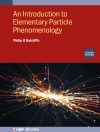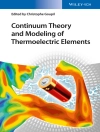Springer Handbook of Condensed Matter and Materials Data provides a concise compilation of data and functional relationships from the fields of solid-state physics and materials in this 1200 page volume. The data, encapsulated in 914 tables and 1025 illustrations, have been selected and extracted primarily from the extensive high-quality data collection Landolt-Börnstein and also from other systematic data sources and recent publications of physical and technical property data. Many chapters are authored by Landolt-Börnstein editors, including the prominent Springer Handbook editors, W. Martienssen and H. Warlimont themselves.
The Handbook is designed to be useful as a desktop reference for fast and easy retrieval of essential and reliable data in the lab or office. References to more extensive data sources are also provided in the book and by interlinking to the relevant sources on the enclosed CD-ROM.
Physicists, chemists and engineers engaged in fields of solid-state sciences and materials technologies in research, development and application will appreciate the ready access to the key information coherently organized within this wide-ranging Handbook.
From the reviews: ‘.this is the most complete compilation I have ever seen. When I received the book, I immediately searched for data I never found elsewhere., and I found them rapidly. No doubt that this book will soon be in every library and on the desk of most solid state scientists and engineers. It will never be at rest.’ -Physicalia Magazine
İçerik tablosu
Part 1 General Tables Part 1 covers the fundamentals of the physics of condensed matter. Fundamental physical constants are qualitatively described and recently recommended numerical values are presented. A short review of The International System of Units (SI) is given and the concepts of base physical quantities and derived physical quantities on which the SI is founded is explained. A number of non-SI units which are still in use are also discussed. Periodic solids, which represent the major proportion of condensed matter are used to introduce briefly the basics of modern crystallography. A coherent introduction to the formalism required is given and the basic concepts and technical terms are briefly explained.
1.1 The Fundamental Constants1.2 The International System of Units1.3 Rudiments of Crystallography
Part 2 The Elements Part 2 The Elements provides tables of the physical and physicochemical properties of the elements. Emphasis is placed on properties of the elements in the condensed state. The tables are structured according to the Periodic Table. Most of the tables deal with the properties of elements of one particular group of the Periodic Table. Only the elements of the first period (hydrogen and helium), the lanthanides, and the actinides are arranged according to the periods. This synoptic representation is intended to provide a transparent overview of the trends in the data.
Part 3 Classes of Materials Part 3 Classes of Materials starts with the selective treatment of metals that are applied as base and alloying elements of metallic materials. According to common usage, the treatment of metallic materials is based on single elements and of groups of metals with common dominating features. The next class of materials discussed are ceramics. Detailed groupings and definitions of technical ceramics are given and traditional ceramics and cements, silicate ceramics, refractory ceramics, oxide ceramics, and non-oxide ceramics are treated. The physical and physicochemical properties of those polymers, copolymers, and polymer blends which are widely used for scientific applications and in industry are described in the next chapter. The last chapter serves as a source of data and commercial product information on glasses as engineering materials of practical importance.
3.1 Metals.- Magnesium and Magnesium Alloys.- Aluminium and Aluminium Alloys.- Titanium and Titanium Alloys.- Zirconium and Zirconium Alloys.- Iron and Steels.- Cobalt and Cobalt Alloys.- Nickel and Nickel Superalloys.- Copper and Copper Alloys.- Refractory Metals.- Noble Metals.- Lead and Lead Alloys3.2 Ceramics3.3 Polymers3.4 Glasses
Part 4 Functional Materials Part 4 covering functional materials is organized in a two-step approach. The first step corresponds to searching for the substance of interest, that is, the relevant group of substances. The second step corresponds to the physical property of interest. The subsections are characterized by the groups of the Periodic Table to which the constituent elements belong. For each group of substances, the physical properties are organized into four classes. These are: A Crystal Structure, Mechanical and Thermal Properties; B Electronic Properties; C Transport Properties; D Electromagnetic and Optical Properties. These property classes are further subdivided into individual properties. Materials covered are semiconductors, superconductors, magnetic materials, dielectrics and electrooptics, and ferro- and antiferroelectrics.
4.1 Semiconductors4.2 Superconductors4.3 Magnetic Materials4.4 Dielectrics and Electrooptics4.5 Ferroelectrics
Part 5 Special Structures Part 5 covers special structures such as liquid crystals, solid surfaces and mesoscopic and nanostructured materials. The chapter on liquid crystals covers physical properties of the most common liquid crystalline substances as well as some liquid crystalline mixtures. Data compiled in the chapter on solid surfaces refer to atomically clean and well characterized surfaces. The values reported are mainly averages from different authors with errors given as standard deviations where reference to the original papers is made. In the chapter on nanostructured materials emphasis is placed on size and confinement effects. The properties associated with electronic confinement are addressed and both quantum wells and quantum dots are reviewed. Particular attention is drawn to semiconductor-doped matrices. The two main applications of nanostructured magnetic materials, spintronics and ultrahigh-density data storage media, are also treated.
5.1 Liquid Crystals5.2 Surfaces5.3 Mesoscopic and Nanostructured Materials
About the Authors
Subject Index












